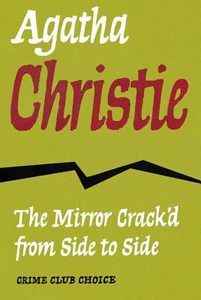“The Mirror Crack’d from Side to Side” (1962) has nothing to do with a mirror (the line comes from a Tennyson poem), but it’s about a lot of other things at a pivotal time in history. Agatha Christie pontificates on new housing construction, the decline of household help, the rise of new fashions, and celebrity culture.
A bevy of colorful characters – those tending to the elderly (but still sharp!) Miss Marple and those fawning over emotionally fragile film actress Marina Gregg – makes “Mirror” a consistently fun read. But it’s Christie’s whiz-bang conclusion that makes this novel a contender for top-10 status.
Changing times
Before we get to that, “Mirror” develops an evocative sense of time and place. A Development – Christie uses a capital D, as do her characters – has been built on what was once an open field next to St. Mary Mead.

“The Mirror Crack’d from Side to Side” (1962)
Also published as: “The Mirror Crack’d”
Author: Agatha Christie
Series: Miss Marple No. 8
Genre: Mystery
Setting: St. Mary Mead and vicinity, 1962
Even the village-based Victorian structure, Gossington Hall (returning from “The Body in the Library,” as does Mrs. Bantry, who has since sold the home), has been refurbished with bathrooms, bigger rooms and modern amenities.
Miss Marple is her usual delightful self in “Mirror,” but I wonder if Christie uses the sleuth to reflect on her own aging. The author was 72, perhaps starting to require minor daily help. As she also did in “A Pocket Full of Rye” a decade prior, Marple reflects that good household help is hard to find nowadays.
Marple amusingly (to us) fends off her live-in helper, Miss Knight, who always enquires about how “we” are doing today. And Marple notes that daily housekeeper Cherry uses a loud vacuum cleaner rather than a perfectly serviceable broom and dustpan.
As always, Marple works through the crime from her sitting-room chair, relying on information from friends and the lead detective, plus gossip magazines (!). I realized after I closed “Mirror” that Christie withholds key information (from Marple and us) for a long time. Marple puts it together once she finally sees a key clue for herself. But I loved the overall experience despite the somewhat artificial delay.
Setting the scene
Christie wonderfully stages the initial murder amid a fete at Gossington Hall. As Gregg greets her guests in a lounge atop the stairs, she freezes in a fugue state. A drink gets spilled. Soon, Gregg’s longtime fan Mrs. Badcock is dead of a drug overdose.
It’s fun how witnesses replay this scene for Inspector Dermot Craddock, each telling it slightly differently. We know the answers are found amid the details, but they are hard to pin down. Despite the slight cheat I mentioned above, I was blown away by the solution to this mystery. As she so often does, Christie tricked me even though she lays it all out.

Marple reminds us that mysteries are not as complicated as we tend to assume. In chapter 21, Craddock playfully suggests that Miss Knight is the killer:
“Because she’s the most unlikely person,” said Dermot. “It so often seems to hold good when you produce your answer.”
“Not at all,” said Miss Marple with spirit. “I have said over and over again, not only to you, my dear Dermot, that it is always the obvious person who has done the crime. One thinks so often of the wife or the husband and so very often it is the wife or the husband.”
But some things never change
Marple notes that human nature hasn’t changed much. Marple’s memory for people she has known in St. Mary Mead (and therefore the types of people in the world) allows her to solve murders, even though – as one character puts it – she looks 100 years old.
However, the superficialities of society do change, and Marple (and Christie herself?) isn’t thrilled. “Mirror’s” observations on the contrasts between village life and Development life – which arguably echo America’s rise of the suburbs – are resonant. Every generation looks upon a new generation’s styles and behaviors with wariness.
Marple observes the Development in chapter 2:
But now she was here, observing the brave new world that was springing up, the world that by all accounts was foreign to all she had known. It was like a neat model built with child’s bricks. It hardly seemed real to Miss Marple.
The people, too, looked unreal. The trousered young women, the rather sinister-looking young men and boys, the exuberant bosoms of the fifteen-year-old girls. Miss Marple couldn’t help thinking it all looked terribly depraved.
Luckily, readers don’t have to adjust too much. “The Mirror Crack’d” is as good as Christie’s mysteries from before widespread indoor plumbing and celebrity worship.
Every week, Sleuthing Sunday reviews an Agatha Christie book or adaptation. Click here to visit our Agatha Christie Zone.

